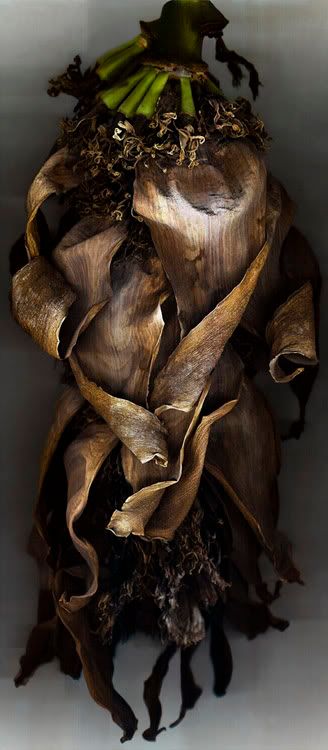
Art ltd. Magazine features Jane O'Neal's Cavendish Floral Stalk in Marlena Doktorczyk's review of Environmental Memory: Part I - Home Grown, which was shown at DNJ Gallery from April 25 - June 20, 2009.
by marlena doktorczyk-donohue
my brain harvests - then constructs - fabrications - of irony - delight - fear and dread – Excerpt, Jane O’Neal, artist’s statement
To analogize Jane O’Neal’s recent incursion into backyard fauna to Georgia O’Keeffe’s distantly similar content seems to completely miss the point; namely, the fresh technical aspects and innovations that make this work unique in a sea of still-lifes and a decade of digitally-based photo images. We know Jane O’Neal for her naturally lit, night cibachromes capturing people-less motel facades, abandoned shopping carts, and backyard swimming pools in the incandescent high pitched hues of backlit neon. What made these stunning—besides O’Neal’s impeccably eccentric eye and dead-on technical instincts—was that the absent humanity was like a breath over the scenes, always suggesting a human presence.
In her new work, O’Neal presses backyard plants—onions, bananas, flowering cacti—onto her scanner then makes nuanced, calibrated ink jet prints on archival paper. Although once again we humans, bursting with what Deleuze called all our “overwhelming versatility of desire” are absent, our generic need and our irreversible decay is suggested in absentia via things related to us: a turgid, red-orange persimmon caught both from the stem-top and in profile such that tiny dots of over-ripening suggest living flesh, or a mature star cluster about to birth a few more universes. Because the scanner renders such unusual and unpredictable relationships of depth/light, because the digital medium provides for an array of intense, tinsel-y saturated color, and because O’Neal is so skilled at what is left in, removed or exaggerated, each work looks like an enlarged page from those medieval hand-drawn botanicals, either created or viewed on really mellow acid. Due to the light of the scanner and the artist’s skill, many images get this sort of Kirlian aura around them, reminding us of studies that purported to “photograph” the life force around plants. Others are crisp with a radioactive luminosity and 3-D sheen, calling to mind gardens propagating out of control and glowing oddly after a nuclear catastrophe. The works swing from the intensely erotic to the sadly senescent; they speak indirectly to the complex relationship between lived life and dues ex machina, and they point to the heart of what is human though no humans are spied.
For a printable version of this review click here!

No comments:
Post a Comment